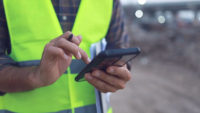Utilizing smart access management technology bolsters security

Photo credit: United Rentals
Construction site managers and safety managers bear the tremendous responsibility of helping to ensure the safety and security of a jobsite and the workers in it. It’s a tall order, one that requires leveraging a variety of tools and approaches to mitigate a wide range of potential hazards. But there is one common strategy that can increase the safety of every worker on virtually every jobsite: access management.
Keeping unauthorized people off the jobsite is an essential step in heading off accidents and injuries as well as theft and vandalism. Preventing unauthorized workers from operating equipment is even more vital, since operators who lack appropriate training are more likely to injure themselves or nearby workers and damage equipment or structures.
By optimizing technology related to site access and equipment access, connected jobsites provide effective solutions to enhance jobsite access management and equipment access management.
Managing jobsite access
Construction sites are busy, hazardous places. Fences and security cameras help deter trespassers, but a method of jobsite access management is necessary to ensure that only authorized workers and visitors pass through entry points, and to generate a record of entrants.
On large jobsites in particular, paper sign-in sheets at guard stations are simply inadequate. Worker ID badge scanning is a more rigorous method and provides a digital record of who entered the site and when. It leverages badges that are issued by workforce management companies and enabled with radio frequency identification (RFID), near-field communications (NFC) or Bluetooth low energy (BLE) technology.
Scanning badges with handheld scan guns is manual and repetitive, however, and it ties up security personnel who could otherwise be allocated to other tasks, such as searching bags or patrolling the site. What’s more, guard stations on their own aren’t physical barriers; especially during peak periods, as it is possible that entrants bypass the guard station(s).
Smart turnstiles provide a physical barrier to entry and automate jobsite access management. Modular units from some manufacturers come with one to 10 lanes and integrate with perimeter fencing. Some come with guard stations. A card reader authenticates entrants based on worker profiles stored in the workforce management software system. The profiles contain basic data such as name, company and trade as well as records of safety training that may be legally required for site entry.
Turnstile units and other access management solutions can be installed not only at site entry points but also at entrances to sensitive buildings or areas. They create a searchable digital log of who is currently on site and who is in specific areas, which can be critical in the event of an emergency.
Managing equipment access
All construction equipment is potentially dangerous. Limiting its use to properly trained and certified operators is the best way to mitigate risk. Most construction companies strive to meet this goal, with varying degrees of success.
Keypad ignition locks are a smart solution, particularly when PINs are assigned on an individual basis. (Sharing the same PIN with every operator frequently leads to PIN sharing, and it fails to create personal accountability.) For large jobsites with large fleets, however, assigning hundreds or thousands of unique PINs can be prohibitively time consuming.
By leveraging the on-boarding process related to worker ID badges for equipment access management we are able to generate accurate real-time and historical insights into equipment utilization. Adding a card reader to keypad ignition locks enables this approach.
In the event of a safety incident or damage to the equipment, managers can easily review which worker used a machine and when. Authorized workers who operate equipment in inappropriate ways can be assigned incremental operator safety training.
The role of a worksite management platform
Central to the desired outcome of a connected job site is the digital worker profile associated with the company-issued badge. For companies that want to seamlessly optimize and manage jobsite and equipment access management, these profiles should be imported into a cloud-based worksite management platform that enables both.
When it comes to equipment access management, we should evolve towards an operational environment that grants access to specific trades, groups or individuals, either for specific pieces of equipment or entire equipment category classes. This capability provides not only an unprecedented level of safety and productivity enhancements, but also, provides “game-changing” levels of control and insight. The same platform may also enable the monitoring of worker location and wellness via wearable devices.
Creating a safe and secure construction site means controlling access to both the jobsite and equipment. As jobsites become larger and more complex, scalable access management solutions are a must. Modern badge-based technologies provide an efficient and effective option.
Looking for a reprint of this article?
From high-res PDFs to custom plaques, order your copy today!






